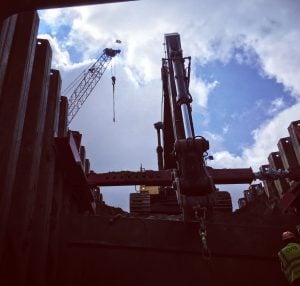A suspended scaffold is a marvelous tool for workers to utilize to gain access to work locations that would be difficult if not impossible to otherwise reach. Unfortunately, the general perception is that suspended scaffolds, particularly two point suspended scaffolds such as window washers two point suspended scaffolds, are inherently dangerous and those individuals who use them are similarly inherently dangerous. This is due in no small part to the media exposure that suspended scaffold failures receive. The reality indicates otherwise. Perhaps these questions and answers will help mitigate the fear of suspended scaffolds.
What is a suspended scaffold? A suspended scaffold is a temporary platform that is supported by non-rigid means such as cables, chains or ropes. It is not to be confused with supported scaffolds which are temporary platforms that are supported by rigid means such as legs, posts or frames.
Is a suspended scaffold the same as a hanging scaffold? No. A hanging scaffold is a “temporary work platform without support from below, secured to an overhead structure using fixed length rigid suspension members” while a suspended scaffold utilizes non-rigid suspension members.
In addition to a guardrail system, are users of all suspended scaffolds required to wear personal fall protection equipment? No. A user of a single point or two point suspended scaffold, that is a platform suspended from either one rope or two ropes, must wear personal fall protection equipment properly connected to a lifeline. The reason for this requirement when using a single point suspended scaffold is obvious: if the rope breaks, you are in big trouble if you aren’t wearing a harness connected to a lifeline and anchor. On a two point suspended scaffold, typically only one line breaks, leaving the platform hanging vertically (and making really cool photos for the media) with one worker dangling from his lifeline while the other worker is desperately clinging to the other suspension rope.
Are you telling me that workers utilizing a temporary platform that is supported by four suspension wire ropes don’t have to wear harnesses secured to an adequate anchor?According to most regulations, yes.
That doesn’t sound right—are you messing with me? Nope.
Why doesn’t a multi-point suspended scaffold user have to wear a harness attached to an adequate anchoring system? It is assumed that the platform is sufficiently rigid so that if one suspension rope fails, the platform will remain more or less level and the workers will not slide/fall off the platform. Of course, if your platform lacks the necessary rigidity, you should be utilizing personal fall protection. For example, if you are suspended by three ropes, you probably need to utilize personal fall protection for the unlikely event that you will lose one of your suspenders. On the other hand, if you are on a rigid platform suspended by many suspension lines, such as a suspended platform under a bridge, personal fall protection is probably not warranted. Of course, you must always comply with the qualified scaffold designer’s instructions.
Why do single and two point suspension scaffolds seem to frequently fail? They don’t. If you look at how many suspended scaffolds are used daily in North America, you will find that the failures are insignificant. It’s just that the media likes to report them, You Tube likes to show them and people like to talk about them! (Of course, if you are the worker who experiences a failure, it probably won’t seem insignificant to you.)
Does a cantilever beam used to support the rope that supports an elevated suspended temporary platform have to be designed by a Professional Engineer? Maybe and maybe not.
When is a Professional Engineer required? First of all, the Professional Engineer has to be qualified. That qualified Professional Engineer is required for all multi-point masons suspended scaffolds where the cantilever beams used to support the ropes are secured to the floor. Usually a qualified Professional Engineer is required to design the cantilever beam and rigging, particularly if it is purpose designed for a specific situation. Also keep in mind that many agencies, such as Departments of Transportation, require a qualified Professional Engineer be involved.
Are suspended scaffold erectors required to utilize (wear) personal fall protection equipment? Erectors are expected to utilize personal fall protection equipment when they are exposed to a fall hazard, such as when they are installing rigging on a roof or open sided floor.
Do suspended scaffold users have to have a license/permit to operate a suspended scaffold? Perhaps; it depends on the jurisdiction. Large cities, some counties and state governments require licensing and/or permitting. Before starting any scaffold project, it would be wise to determine the necessary regulatory requirements.
Is a temporary suspended scaffold the same as a permanent suspended scaffold? No. Temporary suspended scaffolds must comply with a different set of regulations and standards than a permanent installation, known as a “PI.” As the names suggest, a temporary suspended scaffold is commonly used in the construction of new structures and intermittent maintenance while a PI is specifically designed for a building, installed permanently on that building, and is intended to be used for providing routine maintenance and renovation.
What appears to be the most common cause of suspended scaffold failures and why? The most apparent cause is lack of training. There are so many safety devices incorporated into temporary suspended scaffold equipment, such as overspeed brakes and extremely high safety factors that it requires ignorance and possibly purposeful stupidity to make them fail.
What is the most important aspect of suspended scaffold utilization? Training.
Where can I get that training? One good source is the Scaffold & Access Industry Association.













